

None Elected

Richard McPherren Cabeen
(May 11, 1887 – April 13, 1969) Chicago
Cabeen was one of the country's greatest philatelic writers. He began his philatelic career in 1913, writing for The Collector's Journal and Weekly Philatelic Gossip. On September 11, 1932 his first stamp column appeared in the Chicago Sunday Tribune, and he continued as its stamp editor for 37 years, until his death.
Cabeen wrote a series of 31 monographs under the general title of The Chicago Tribune Series of Booklets on United States Stamps, each covering a different aspect of stamp collecting or a recent stamp issue. They appeared between 1934 and 1939. He wrote The Standard Handbook of Stamp Collecting (1957), which was widely used and reprinted a number of times, most recently in 1979.
Cabeen collected and studied the U.S. 3-cent 1851-57 stamps and, working with Carroll Chase, completed a full plating. Cabeen was a pioneer student of Chicago and Illinois postal history. He and Chase co-authored The First Hundred Years of Territorial Postmarks 1787-1887, first published as a series of articles in The American Philatelist, (October 1941 - April 1950) and then published in book form by the A.P.S. Philatelic Research and Literature Committee (1950).
Cabeen was an Honorary Life Member of the Chicago Philatelic Society, and received its Newbury Award in 1953. He bequeathed his Chicago townhouse to the Collectors Club of Chicago as its club home and center for Chicago Philately. In his honor, in 1971, the Collectors Club of Chicago published Chicago Postal History: Selections that Honor the Collecting Interests of Richard McP. Cabeen (edited by Harvy M. Karlen).
Cabeen received
the Luff Award in 1966 for Distinguished Philatelic Research.
Lloyd B. Gatchell
(September 24, 1901 – October 3, 1969) New York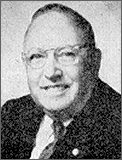
Gatchell was an enthusiastic collector and internationally recognized advocate of aerophilately. As a teenager, he edited and published the Claremont Philatelist (1916-1920). In 1918, when the U.S. issued its first airmail stamps, Gatchell turned his interest to aerophilately, and continued it for the rest of his life.
"Bart" served the American Air Mail Society in many capacities, notably as secretary (1929-1937) and president (1934-1938). Known as “Mr. AAMS,” he edited The Air Post Journal from 1942 to 1955. He was editor-in-chief of The American Air Mail Catalogue (1940) and worked on subsequent editions. At the time of his death he was working on the fourth edition.
Gatchell received
numerous national and international awards, notably the Walter J.
Conrath Memorial Award from the AAMS and the Glen W. Naves Medal
from the Fédération Internationale des Sociétés
Aerophilatéliques.
Judge Donald Fisher Lybarger
(December 19, 1896 – November 6, 1970) Cleveland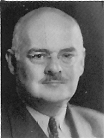
Judge Lybarger was an active participant in national and local philately. He was a well-known figure in the Cleveland area, most notably as member and officer of the Garfield-Perry Stamp Club. It made him an Honorary Life Member because of his long service to the club.
Lybarger's main collecting interest was in 20th century U.S. stamps. He wrote The United States Issues of 1918-1920, published in 1937 as American Philatelist Handbook No. 2. He served as APS President from 1943 to 1949, and led the reorganizing, promoting and expansion of the APS in the wartime and post-World War II years that were crucial to philately.
Lybarger received the Luff Award in 1950 for Exceptional Contributions to Philately. He was presented a special APS Gold Medal just before his death in recognition of his long service and many contributions to philately and the APS.

Sir Edward Denny Bacon, K.C.V.O.
(August 29, 1860 – June 5, 1938) England
Bacon was one of Britain's most outstanding philatelists of all time. In his lifetime, he was called “Our National Philatelist.” In 1880 he joined the Philatelic Society, London (now the Royal Philatelic Society London), and from the start served in various official capacities. He was a prolific writer and serious student of a wide range of philatelic subjects for the rest of his life.
Bacon's first of many books, Saint Vincent: With Notes and Publisher's Prices (Francis H. Napier, co-author) was published in 1895. In 1899, he wrote Reprints of Postal Adhesive Stamps and Their Characteristics, an important book about what was a timely subject. It was reprinted in 1954 by Dr. Lowell Ragatz.
His most celebrated book was The Line Engraved Postage Stamps of Great Britain Printed by Perkins, Bacon and Co. (1920). It was awarded the Crawford Medal in 1921.
Bacon was commissioned by the British Museum to catalog and arrange for display the stamp collection formed by Thomas Keay Tapling which was bequeathed to the museum in 1891. The collection is now displayed in the Philatelic Section of the British Library.
A founder of the Philatelic Literature Society (1908) Bacon was commissioned by another founder, James L. Linsday, the Earl of Crawford, to catalog his enormous philatelic library, which included, among others, the library of John Kerr Tiffany. The result was the seminal bibliographic work by Bacon, Catalogue of the Philatelic Library of the Earl of Crawford, K.T. (1911). This library is now housed in the Philatelic Section of the British Library.
In 1913 Bacon became the curator of the stamp collection formed by King George V, an eminent philatelist. During his tenure, Bacon reorganized the King's collection, limiting it to the stamps of Great Britain and its colonies and dominions. Today it is called the Royal Collection (see Sir John Wilson). For this work Bacon was made a Knight Commander of the Victorian Order in 1932.
The philatelic world honored him for his many important works and his lifelong dedication to philately. Bacon received the Lindenberg Medal in 1906, the first year it was awarded. He was one of the original group of philatelists who signed the Roll of Distinguished Philatelists in 1921.
Lester George Brookman
(September 3, 1904 – November 23, 1971) Minnesota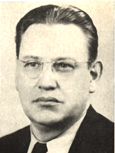
Brookman was one of the foremost authorities on 19th century United States Stamps. He began as a stamp dealer in 1934, and his Brookman's U.S. Price List was used by hundreds of stamp dealers throughout the country as the medium for pricing their stamps. In 1947 he published a two-volume work, The United States Postage Stamps of the 19th Century, which he expanded into a three-volume set in 1967. The APS Writers Unit 30 presented him its Grand Award in 1968 for this edition, which was a philatelic bestseller.
Brookman was editor of The American Philatelist from 1941-1945. He received the Luff Award twice: in 1946 for Exceptional Contributions to Philately and again in 1948 for Distinguished Philatelic Research. Brookman signed the Roll of Distinguished Philatelists in 1950.
Charles Haviland Mekeel
(December 1, 1861 – October 13, 1921) St. Louis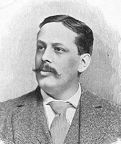
Mekeel was one of America's greatest stamp dealers and editors. He became a dealer in 1877 and continued for the rest of his life. His editing began in 1881 with The Stamp Collectors' Bureau (later called The Collectors' Bureau).
In 1885 Mekeel published Philatelic Journal of America, which became one of the country's leading philatelic journals. It continued for 25 volumes, through 1917, except for volumes 15 to 19 (1901-1905) when it was called Mekeel's Stamp Collector. At the same time, Mekeel published Mekeel's Drummer (1900-1901), Mekeel's News and Trade Journal (1905-1912) and other shorter journals. In 1896, he issued philately's first “daily,” The Daily Stamp News, publishing 285 issues between January and December 1896.
His most famous publication was his Mekeel's Weekly Stamp News, which he began in January 1891 and continued to edit through 1897 (Volume 9). It was the weekly journal of record. He then sold it to his brother Isaac who added Charles Severn and Willard Wylie to the editorship, keeping it as the country's leading weekly into the 1940s.
Mekeel collected and wrote on the stamps of Mexico. He wrote The Mexican Postal Stamp Catalog (1890) and The Postage Stamps of Mexico (1911). For three years (1892-1895) he published a St. Louis-based Spanish language journal, La Revista Filatelica.
Mekeel figured prominently in a famous find of St. Louis Postmaster Provisionals — the St. Louis Bears — that took place in Louisville, Kentucky in 1895. The find, also called the Tyler and Rutherford find, settled any lingering doubts about the plating of the stamps and authenticity of the 20-cent value. It also verified the findings of his colleague, John K. Tiffany, published in 1894. Mekeel wrote The History of the Postage Stamps of the St. Louis Postmaster, 1845-1847 in 1895.

Edith Margaret Faulstich
(May 22, 1907 – September 4, 1972) New Jersey, New York City
Faulstich was a pioneer student and collector of postal history. She campaigned extensively to have postal history recognized as a category at major exhibitions. She was a founder of the Postal History Society of the Americas (now the Postal History Society, Inc.). Faulstich helped the PHS through its early years as the first editor of its Postal History Journal, and as president from 1965 to 1967.
In her philatelic career, “Dee” edited Covers magazine, The Essay-Proof Journal and was associate editor of Western Stamp Collector. She wrote a stamp column in the Bergen (NJ) Evening Record and later in the Newark (NJ) News.
Faulstich built world-class collections of the postal history of the American Expeditionary Forces and the Canadian Expeditionary Forces in Siberia during World War I.
Peter G. Keller
(October 13, 1894 – September 15, 1972) New York
Keller was a director and executive officer of the American Stamp Dealers Association for 25 years. During his tenure, he changed an inactive association of 400 members into a large and influential organization of 1100 members.
From 1947 until he retired in 1966, he and his wife, Helen Van Zilen Keller, were major figures in all the activities of the ASDA. After his retirement as executive officer, he remained on the Board until his death.
In 1949, Keller and his wife organized the first ASDA national show, and they continued to direct them until 1965. These ASDA shows became the largest dealer shows held in the U.S. Keller was also president of the International Federation of Stamp Dealers in 1958-59. He founded the Lions International Stamp Club and was its secretary for many years.
Elliott Perry
(December 30, 1884 – September 27, 1972) New Jersey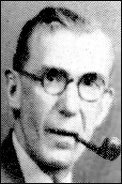
Perry was the dean of researchers of 19th century U.S. stamps. From the 1910s and for the rest of his long life he was involved with building and selling the great collections of US material. His research ranged from revenues to regular issues to carriers and locals. In all areas he made an impact.
Perry's first published works were a long series of articles on US revenue stamps, including the private die proprietary ("match and medicine") stamps. They appeared in Mekeel's Weekly Stamp News, from 1916 to 1930 under the pseudonym "Christopher West" (Perry's wife's maiden name was Christina Westlake). The first group of these articles was published in 1918 as Mekeel's Handbook No. 23: The Revenue Stamps of the United States. The entire series of "Christopher West" articles (1916–1930) on US revenues was reprinted (1978–79) in three volumes (with additional material written later by Perry) published by Castenholz and Co.
Perry wrote two other Mekeel's Handbooks: The First United States Postage Stamp Otherwise Known as the United States City Despatch Post (No. 30); United States 1857–1860 Issues (No. 39), both published in the early 1920s.
One of Perry's most important research projects was his successful plating of the 200 subjects of the U.S.-1847-10¢ stamp (Scott No. 2) which he completed in 1923. His results were published in the Collectors Club Philatelist (July 1924; January–July 1926).
In 1931, Perry began publishing his own journal Pat Paragraphs which he continued until 1952. It is commonly acknowledged as the most important "house organ" on US stamps ever published. After his death, Perry's journal was compiled and arranged by topic and, with additional material added by the Compilers George T. Turner and Thomas E. Stanton, published in 1981 as Pat Paragraphs by Elliott Perry.
Although Perry wrote extensively in all areas of US stamps, much of his published work was devoted to US carriers and locals. With Arthur G. Hall, Perry co-authored two important books. These were The Chatham Square Post Office and Swarts City Dispatch Post (1941), and One Hundred Years Ago: 1842-Centenary of the First Adhesive Postage Stamp in the United States (1942). Perry later expanded the research work of H. Warren K. Hale in Byways of Philately: Privately Owned Posts and Early Locals (1966).
Around 1947, Perry announced his plans to publish three books on the subjects, U.S. Carriers, U.S. Locals, and U.S. Independent Mail (this with Hall). But none were published in his lifetime. His extensive notes and partly-written sections on U.S. Carriers were edited and published posthumously in Robson Lowe's The Philatelist from October 1973 to December 1974 (edited by Maurice Williams) and continued in the U.S. Philatelic Classics Society's The Chronicle of U.S. Classic Postal Issues from February 1982 to August 1986 (edited by Robert Meyersburg).
During his lifetime, Perry was lauded by his colleagues and his many students. Important parts of his research notes and writings on U.S. Locals and the independent mail still remain to be published. Specialists have edited, rewritten and published various sections in the Penny Post and The Chronicle of U.S. Classic Postal Issues. This work continues.

Winthrop Smillie Boggs
(December 20, 1902 – May 30, 1974) New York City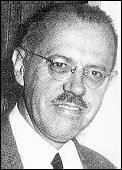
Boggs was a world famous philatelist known for his writings and his expertise. He authored the highly acclaimed book The Foundations of Philately, (1955) which became a philatelic best seller.
Among his other books and writings was Ten Decades Ago: 1840-1850, a Study of the Work of Rawdon, Wright, Hatch and Edson of New York City (1949). His two most famous and much-awarded books were The Postage Stamps and Postal History of Newfoundland (1942) and The Postage Stamps and Postal History of Canada (1945). For the latter, Boggs received the Crawford Medal in 1947.
“Win” was active in the Collectors Club of New York, serving as librarian, governor and editorial consultant. He was the first executive director of the Philatelic Foundation, 1945-1961.
Boggs received
the Luff Award for Distinguished Philatelic Research in 1952 and
the Lichtenstein Medal in 1958. He signed the Roll of Distinguished
Philatelists in 1959.
Solomon Glass
(March 8, 1893 – March 7, 1973) Baltimore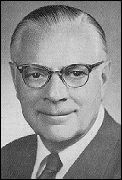
Glass was one of the greatest experts of United States 20th century stamps. His book, United States Postage Stamps 1945-1952 (1954) received national and international awards. Glass was also an international philatelist. In 1955 he became the first American member of the Executive Board of the Fédération Internationale de Philatélie which, in 1966, awarded him its Medal for Distinguished Service.
Glass was a member of the first Citizens' Stamp Advisory Committee from 1957 to 1961. For his service, the U.S Post Office Department gave him the Benjamin Franklin Award for Distinguished and Outstanding Public Service. “Sol” was active in the Baltimore Philatelic Society and served as president as well as in other offices.
He served the APS
in many roles, including on the Board of Vice-Presidents from 1943
to 1947. He was also an officer in the American Philatelic Congress
(1945-1973) and the Bureau Issues Association (now the United States
Stamp Society) (1950-1961). He wrote The Story of United Nations
Postage Stamps in 1953, which was later reprinted and issued
as an official UN publication. Glass received the Luff Award in
1954 for Distinguished Philatelic Research.
Edwin Müller (Mueller)
(December 2, 1898 – October 4, 1962) Austria, New York City
Ing. Edwin Müller was one of the greatest philatelists of all time. His career spanned two eras and two continents. In the 1920s and 1930s he was one of Europe's most distinguished experts, writers and editors. He was forced to leave his native Vienna in 1938 and came to the United States. From 1938 until his death he was a world-famous dealer, auctioneer, expert, writer and editor. (In the U.S., he wrote his name as Edwin Mueller.)
In Vienna, Müller edited the influential journal, Die Postmarke from the mid-1920s until his move to the United States. In that period he carried out a detailed study of the philately of the Austro-Hungarian Empire. He published a series of important handbooks on the postmarks of Austria and Lombardy-Venetia from the pre-adhesive period through the 1860s. He also wrote on many other philatelic topics. Just before he left Austria, his book, Grundbegriffe der Postwertzeichenkunde (Fundamentals of Philately) was published.
During the 1930s Ing. Müller was a philatelic advisor to the Austrian Government. He was an official and a juror at most national and international philatelic exhibitions of that time. He was a member and president (1933) of the Fédération Internationale de la Presse Philatélique.
In 1933 Edwin Müller managed the organization that staged the International Philatelic Exhibition in Vienna (WIPA 33), one of the best pre-World War II stamp exhibitions. For his many accomplishments, the Austrian government awarded him its Cross of Honor.
In 1938, when Edwin Müller arrived in the United States, he joined J.M. Bartels, and helped arrange a series of Special Rarity Sales from 1939 to 1941. These sales included portions of the world-famous European classics collection of Baron Alphonse de Rothschild who had recently fled from Vienna.
In 1941, Mueller joined the eminent dealer and expert Otto Friedl to form the Friedl Co. in order to sell further sections of the Rothschild collection. (Friedl had also recently fled his native Vienna.) Mueller and Friedl also offered an expertising service for mostly European classic stamps, and helped further the study and collecting of them by American philatelists. In 1943, Mueller and Friedl formed the Mercury Stamp Company, selling privately and at auction many important collections of classic stamps. Besides further Rothschild material, Mercury sold parts of other important European collections.
In 1948, Mueller and Friedl were joined by Herbert Bloch to form the Friedl Expert Committee, increasing the scope of their expertising service on mainly European classic stamps and covers.
Mueller updated many of his earlier works, publishing Postmarks of Austria (1950), Handbook of the Pre-stamp Postmarks of Austria (1960) and, with Marc Fitch, Handbook of Austria and Lombardy-Venetia Cancellations (1961). He also wrote the Catalog of the Imperforate Classic Postage Stamps of Europe (1958). His bilingual Specialized Catalog of Austria 1850 to 1918 (1952) is still considered important by Austrian Collectors.
In 1947, Mueller established the scholarly Mercury Stamp Journal, which he edited and wrote until his death. He wrote a series of articles on European classic stamps, arranged alphabetically by country. His last article was on the Netherlands.
Return to Top




